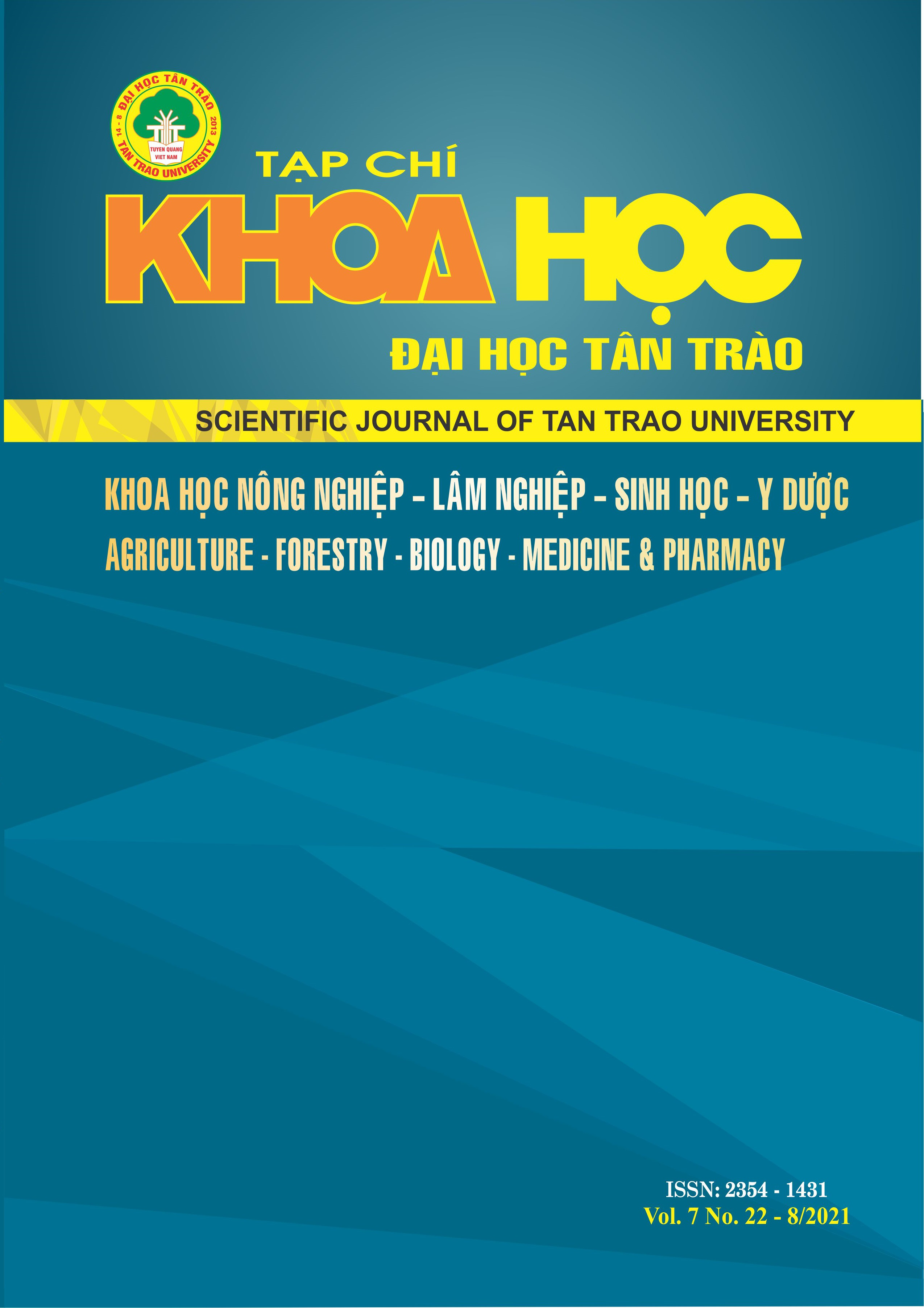NGHIÊN CỨU TUYỂN CHỌN VÀ ĐỊNH LOẠI CHỦNG LỢI KHUẨN LÊN MEN LACTIC TỪ QUẢ SIM (Rhodomyrtus tomentosa)
DOI:
https://doi.org/10.51453/2354-1431/2021/559Từ khóa:
Môi trÆ°á»ng lên men, quả sim, Lactobacillus plantarum L5, lactic.Tóm tắt
Cây sim mọc tự nhiên ở hầu hết các thôn trên địa bàn xã Côn Lôn, ngoài các giống phổ biến trên địa bàn nghiên cứu thì Rhodomyrtus tomentosa hiếm gặp hơn. Ở địa phương, quả sim được sử dụng chủ yếu nhiều để ngâm rượu, ăn tươi bên cạnh các sản phẩm chế biến từ quả như mứt sim, mật sim, vang sim. Dịch ép quả sim có hàm lượng tanin, hàm lượng vitamin C cao, có ý nghĩa lớn trong kháng khuẩn. Sử dụng các phương pháp nghiên cứu đặc thù chúng tôi đã phân lập được 5 chủng lactic kí hiệu từ L1-L5. Định danh chủng L5 bằng việc giải trình tự 16S rADN của chủng kết quả thu được Lactobacillus plantarum (L. plantarum) thuộc chi Lactiplantibacillus, đặt tên chủng là: L. plantarum L5.
Tải xuống
Tài liệu tham khảo
[1] Ataei, S., Azari, P., Hassan, A., Pingguan-Murphy, B., Yahya, R., & Muhamad, F. (2020). Essential oils-loaded electrospun biopolymers: A future perspective for active food packaging. Advances in Polymer Technology.
[2] Dallal, M. S., Davoodabadi, A., Abdi, M., Hajiabdolbaghi, M., Yazdi, M. S., Douraghi, M., Bafghi, S. T. (2017). Inhibitory effect of Lactobacillus plantarum and Lb. fermentum isolated from the faeces of healthy infants against nonfermentative bacteria causing nosocomial infections. New microbes and new infections, 15:9-13.
[3] Enan, G., El-Essawy, A., Uyttendaele, M., Debevere, J. (1996). Antibacterial activity of Lactobacillus plantarum UG1 isolated from dry sausage: characterization, production and bactericidal action of plantaricin UG1. International journal of food microbiology, 30(3), 189-215.
[4] Huynh, N. T. D., Nguyen, T. H. (2016). Biochemistry textbook (For pharmacy college students). Tay Do University, Vietnam.
[5] Lai, T. N. H., André, C., Rogez, H., Mignolet, E., Nguyen, T. B. T., Larondelle, Y. (2015). Nutritional composition and antioxidant properties of the sim fruit (Rhodomyrtus tomentosa). Food chemistry, 168, 410-416.
[6] Muhammad, Z., Ramzan, R., Abdelazez, A., Amjad, A., Afzaal, M., Zhang, S., Pan, S. (2019). Assessment of the antimicrobial potentiality and functionality of Lactobacillus plantarum strains isolated from the conventional inner Mongolian fermented cheese against foodborne pathogens. Pathogens, 8(2):71.
[7] Okano, K. T. T., Ogino, C., Fukuda, H., Kondo, A. (2010) Biotechnological production of enantiomeric pure lactic acid from renewable resources: recent achievements, perspectives, and limits. Microbiol Biotechno., 85(3), 413-423. doi: 10.1007/s00253-009-2280-5. PMID: 19826806..
[8] Qian, Z., Zhao, D., Yin, Y., Zhu, H., Chen, D. (2020). Antibacterial activity of lactobacillus strains isolated from Mongolian yogurt against Gardnerella vaginalis. BioMed research international.
[9] So, P., Thuan, B. (1991). Food and food testing. Faculty of Food Chemistry, Hanoi University of Science and Technology, 27, 34, 81-85.
[10] Sensory assessment – Beverage evaluation technical standard (2009).
[11] National standard for white wine – Determination of acid content (2016).
Tải xuống
Đã Xuất bản
Cách trích dẫn
Số
Chuyên mục
Giấy phép

Tác phẩm này được cấp phép theo Giấy phép Quốc tế Creative Commons Attribution-ShareAlike 4.0 .
Bài báo được xuất bản ở Tạp chí Khoa học Đại học Tân Trào được cấp phép theo giấy phép Ghi công - Chia sẻ tương tự 4.0 Quốc tế (CC BY-SA). Theo đó, các tác giả khác có thể sao chép, chuyển đổi hay phân phối lại các bài báo này với mục đích hợp pháp trên mọi phương tiện, với điều kiện họ trích dẫn tác giả, Tạp chí Khoa học Đại học Tân Trào và đường link đến bản quyền; nêu rõ các thay đổi đã thực hiện và các nghiên cứu đăng lại được tiến hành theo cùng một bản quyền.
Bản quyền bài báo thuộc về các tác giả, không hạn chế số lượng. Tạp chí Khoa học Tân Trào được cấp giấy phép không độc quyền để xuất bản bài báo với tư cách nhà xuất bản nguồn, kèm theo quyền thương mại để in các bài báo cung cấp cho các thư viện và cá nhân.
Mặc dù các điều khoản của giấy phép CC BY-SA không dành cho các tác giả (với tư cách là người giữ bản quyền của bài báo, họ không bị hạn chế về quyền hạn), khi gửi bài tới Tạp chí Khoa học Đại học Tân Trào, tác giả cần đáp ứng quyền của độc giả, và cần cấp quyền cho bên thứ 3 sử dụng bài báo của họ trong phạm vi của giấy phép.






